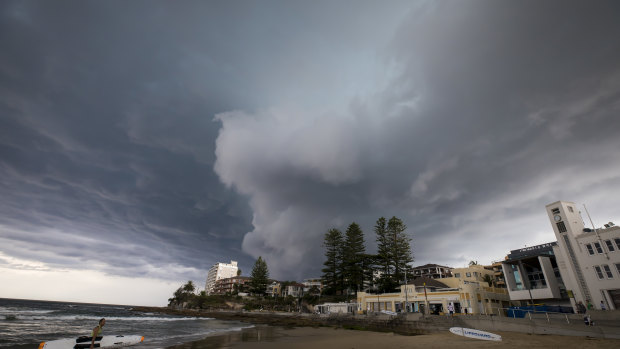This was published 3 years ago
Climate change to deliver suburban house price pain: RBA
By Shane Wright and Mike Foley
Climate change could cut property prices across a swath of Sydney’s northern suburbs from Lane Cove to Ku-ring-gai, with Reserve Bank analysis showing many homeowners face declining equity in their houses and rising insurance costs.
As separate work by the RBA warned coal and LNG exports to key Asian markets were likely to fall as nations such as China and South Korea reduced their carbon emissions, the bank’s research on the Australian property market suggested climate change was a growing risk to the financial sector.

A storm rolls into Cronulla beach, where Reserve Bank research shows climate change could increase the cost of property insurance. Credit: Anna Kucera.
Economists Kellie Bellrose, David Norman and Michelle Royters found by 2050, about 400,000 more loans (or 2.5 per cent of all loans) would have a loan-to-value ratio of more than 80 per cent – half of those with an LVR of more than 90 per cent – as property values fell due to climate change.
They suggested there would be 254 “climate-sensitive suburbs” at increased risk of a drop in value by that time, rising to 1438 suburbs by 2100.
In Sydney, most of the city’s northern suburbs from Mosman to the northern beaches and across to the Ku-ring-gai area stretching past Hornsby fell into this category, along with the Cronulla peninsula. Almost every coastal suburb in Brisbane was considered climate-sensitive, as was the area around Lilydale, Croydon and Kilsyth in Melbourne’s outer east and Mandurah to the south of Perth.
In Australia, about two-thirds of major bank lending is for residential mortgages, making any change in housing values a key risk.
The Australian Prudential Regulation Authority is working with the nation’s largest banks to identify their potential vulnerability to climate change amid growing global recognition of the risks it poses to the entire financial system.
The United Nations Intergovernmental Panel on Climate Change’s (IPCC) latest report confirmed the world was on track to experience extreme weather due to global warming even if swift action was taken to limit global warming to 2 degrees. It predicted Australia, which has warmed 1.4 degrees since 1910, would experience rising average temperatures with extreme heat, more frequent and intense bushfires, droughts, floods and rising sea levels.
The RBA economists said the risks in climate-sensitive suburbs could further increase if the insurance costs for affected areas became prohibitive.
“That is, the technical insurance premium may understate the actual rise in premiums, particularly if insurers become more concerned about exposures to ‘high risk’ regions,” they said. “This may arise because many of the addresses within these regions are impacted by the same hazard (for example, an entire town is built in a flood zone or near fire hazards). In addition, if climate change causes incomes in these regions to also decline, it would result in even larger risks to banks.”
Separate work by RBA economists Jonathan Kemp, Madeleine McCowage and Faye Wang into the impact of climate change mitigation policies by China, Japan and South Korea suggests Australia’s coal and LNG sectors face a tough battle over the next three decades.
Each country has made promises to reach net-zero emissions by 2050, and the three take a large proportion of Australia’s coal and LNG exports.
The researchers found that without any efforts to reduce emissions, coal exports to the three countries would rise by 17 per cent by 2050. But if the nations reached net zero, Australian coal exports would fall by 80 per cent, with two-thirds of that due to the actions of China, Japan and South Korea.
Thermal coal exports this year are expected to reach $21 billion.
Exports of LNG, forecast to be $49 billion in 2021-22, are not expected to fall as much as coal.
According to the researchers, LNG exports would grow between 60 and 80 per cent without any action on climate change. Under net zero, however, they were expected to fall by half, with most of that due to sharp declines in demand from Japan and South Korea.
“The commitments by China, Japan and South Korea to achieve net-zero emissions by mid-century and the broader global shift towards carbon emission reduction puts downward pressure on the outlook for Australia’s fossil fuel exports,” they found.
The Morning Edition newsletter is our guide to the day’s most important and interesting stories, analysis and insights. Sign up here.